Wenhui Liu
Imagination-Limited Q-Learning for Offline Reinforcement Learning
May 18, 2025Abstract:Offline reinforcement learning seeks to derive improved policies entirely from historical data but often struggles with over-optimistic value estimates for out-of-distribution (OOD) actions. This issue is typically mitigated via policy constraint or conservative value regularization methods. However, these approaches may impose overly constraints or biased value estimates, potentially limiting performance improvements. To balance exploitation and restriction, we propose an Imagination-Limited Q-learning (ILQ) method, which aims to maintain the optimism that OOD actions deserve within appropriate limits. Specifically, we utilize the dynamics model to imagine OOD action-values, and then clip the imagined values with the maximum behavior values. Such design maintains reasonable evaluation of OOD actions to the furthest extent, while avoiding its over-optimism. Theoretically, we prove the convergence of the proposed ILQ under tabular Markov decision processes. Particularly, we demonstrate that the error bound between estimated values and optimality values of OOD state-actions possesses the same magnitude as that of in-distribution ones, thereby indicating that the bias in value estimates is effectively mitigated. Empirically, our method achieves state-of-the-art performance on a wide range of tasks in the D4RL benchmark.
Amplitude Prediction from Uplink to Downlink CSI against Receiver Distortion in FDD Systems
Aug 31, 2023

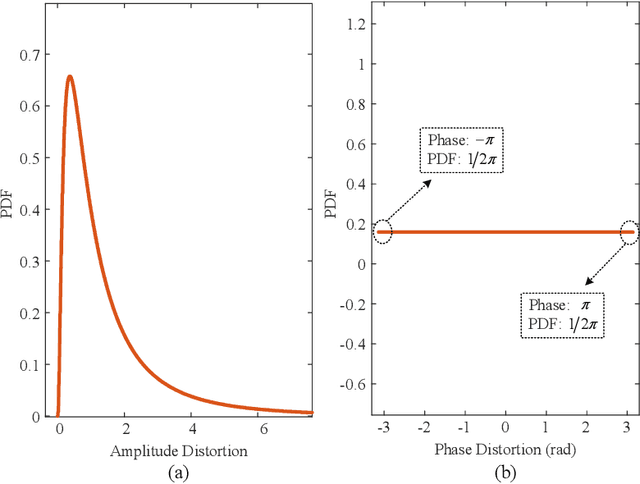

Abstract:In frequency division duplex (FDD) massive multiple-input multiple-output (mMIMO) systems, the reciprocity mismatch caused by receiver distortion seriously degrades the amplitude prediction performance of channel state information (CSI). To tackle this issue, from the perspective of distortion suppression and reciprocity calibration, a lightweight neural network-based amplitude prediction method is proposed in this paper. Specifically, with the receiver distortion at the base station (BS), conventional methods are employed to extract the amplitude feature of uplink CSI. Then, learning along the direction of the uplink wireless propagation channel, a dedicated and lightweight distortion-learning network (Dist-LeaNet) is designed to restrain the receiver distortion and calibrate the amplitude reciprocity between the uplink and downlink CSI. Subsequently, by cascading, a single hidden layer-based amplitude-prediction network (Amp-PreNet) is developed to accomplish amplitude prediction of downlink CSI based on the strong amplitude reciprocity. Simulation results show that, considering the receiver distortion in FDD systems, the proposed scheme effectively improves the amplitude prediction accuracy of downlink CSI while reducing the transmission and processing delay.
LoS sensing-based superimposed CSI feedback for UAV-Assisted mmWave systems
Feb 21, 2023


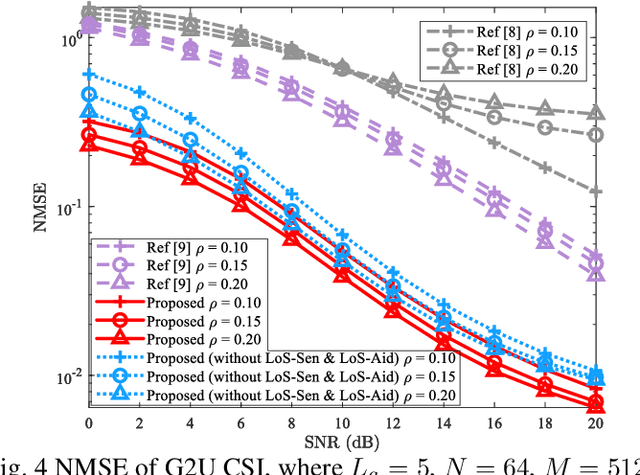
Abstract:In unmanned aerial vehicle (UAV)-assisted millimeter wave (mmWave) systems, channel state information (CSI) feedback is critical for the selection of modulation schemes, resource management, beamforming, etc. However, traditional CSI feedback methods lead to significant feedback overhead and energy consumption of the UAV transmitter, therefore shortening the system operation time. To tackle these issues, inspired by superimposed feedback and integrated sensing and communications (ISAC), a line of sight (LoS) sensing-based superimposed CSI feedback scheme is proposed. Specifically, on the UAV transmitter side, the ground-to-UAV (G2U) CSI is superimposed on the UAVto-ground (U2G) data to feed back to the ground base station (gBS). At the gBS, the dedicated LoS sensing network (LoSSenNet) is designed to sense the U2G CSI in LoS and NLoS scenarios. With the sensed result of LoS-SenNet, the determined G2U CSI from the initial feature extraction will work as the priori information to guide the subsequent operation. Specifically, for the G2U CSI in NLoS, a CSI recovery network (CSI-RecNet) and superimposed interference cancellation are developed to recover the G2U CSI and U2G data. As for the LoS scenario, a dedicated LoS aid network (LoS-AidNet) is embedded before the CSI-RecNet and the block of superimposed interference cancellation to highlight the feature of the G2U CSI. Compared with other methods of superimposed CSI feedback, simulation results demonstrate that the proposed feedback scheme effectively improves the recovery accuracy of the G2U CSI and U2G data. Besides, against parameter variations, the proposed feedback scheme presents its robustness.
Transient motion classification through turbid volumes via parallelized single-photon detection and deep contrastive embedding
Apr 04, 2022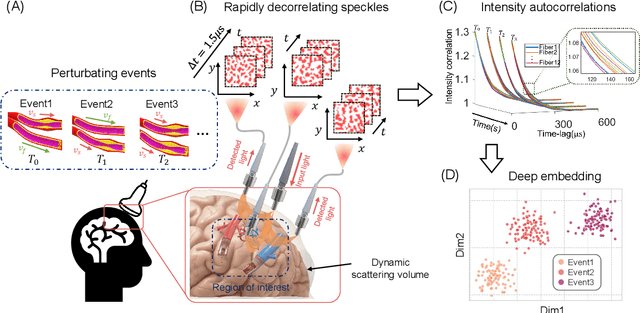
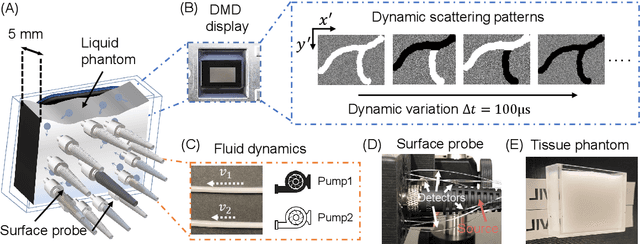
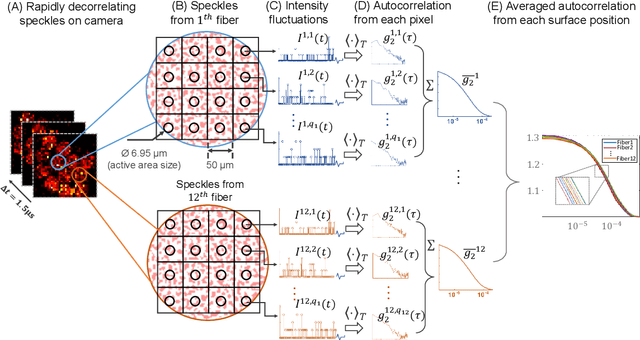
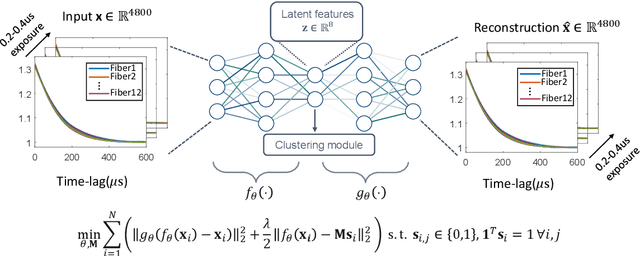
Abstract:Fast noninvasive probing of spatially varying decorrelating events, such as cerebral blood flow beneath the human skull, is an essential task in various scientific and clinical settings. One of the primary optical techniques used is diffuse correlation spectroscopy (DCS), whose classical implementation uses a single or few single-photon detectors, resulting in poor spatial localization accuracy and relatively low temporal resolution. Here, we propose a technique termed Classifying Rapid decorrelation Events via Parallelized single photon dEtection (CREPE)}, a new form of DCS that can probe and classify different decorrelating movements hidden underneath turbid volume with high sensitivity using parallelized speckle detection from a $32\times32$ pixel SPAD array. We evaluate our setup by classifying different spatiotemporal-decorrelating patterns hidden beneath a 5mm tissue-like phantom made with rapidly decorrelating dynamic scattering media. Twelve multi-mode fibers are used to collect scattered light from different positions on the surface of the tissue phantom. To validate our setup, we generate perturbed decorrelation patterns by both a digital micromirror device (DMD) modulated at multi-kilo-hertz rates, as well as a vessel phantom containing flowing fluid. Along with a deep contrastive learning algorithm that outperforms classic unsupervised learning methods, we demonstrate our approach can accurately detect and classify different transient decorrelation events (happening in 0.1-0.4s) underneath turbid scattering media, without any data labeling. This has the potential to be applied to noninvasively monitor deep tissue motion patterns, for example identifying normal or abnormal cerebral blood flow events, at multi-Hertz rates within a compact and static detection probe.
Deep Learning for 1-Bit Compressed Sensing-based Superimposed CSI Feedback
Mar 13, 2022

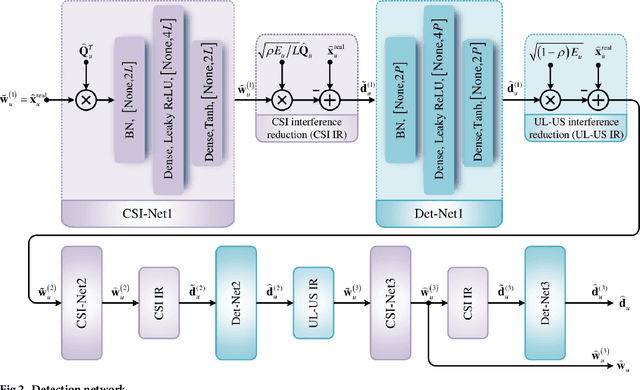
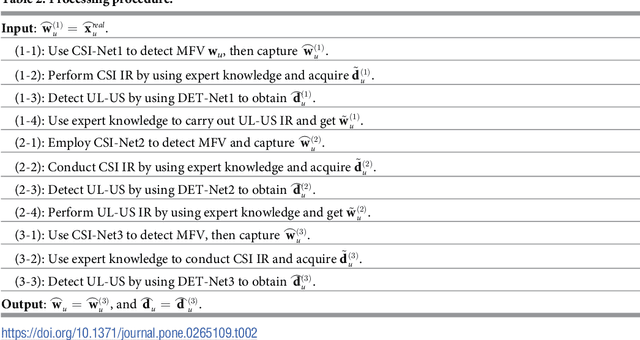
Abstract:In frequency-division duplexing (FDD) massive multiple-input multiple-output (MIMO) systems, 1-bit compressed sensing (CS)-based superimposed channel state information (CSI) feedback has shown many advantages, while still faces many challenges, such as low accuracy of the downlink CSI recovery and large processing delays. To overcome these drawbacks, this paper proposes a deep learning (DL) scheme to improve the 1-bit compressed sensing-based superimposed CSI feedback. On the user side, the downlink CSI is compressed with the 1-bit CS technique, superimposed on the uplink user data sequences (UL-US), and then sent back to the base station (BS). At the BS, based on the model-driven approach and assisted by the superimposition-interference cancellation technology, a multi-task detection network is first constructed for detecting both the UL-US and downlink CSI. In particular, this detection network is jointly trained to detect the UL-US and downlink CSI simultaneously, capturing a globally optimized network parameter. Then, with the recovered bits for the downlink CSI, a lightweight reconstruction scheme, which consists of an initial feature extraction of the downlink CSI with the simplified traditional method and a single hidden layer network, is utilized to reconstruct the downlink CSI with low processing delay. Compared with the 1-bit CS-based superimposed CSI feedback scheme, the proposed scheme improves the recovery accuracy of the UL-US and downlink CSI with lower processing delay and possesses robustness against parameter variations.
Fusion Learning for 1-Bit CS-based Superimposed CSI Feedback with Bi-Directional Channel Reciprocity
Jan 20, 2022

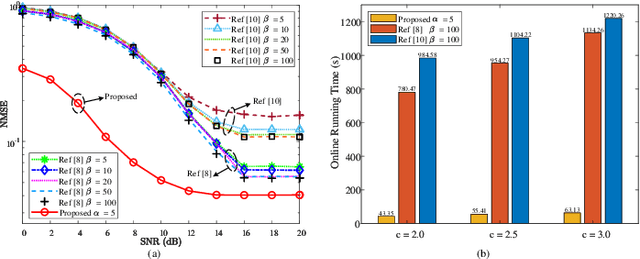
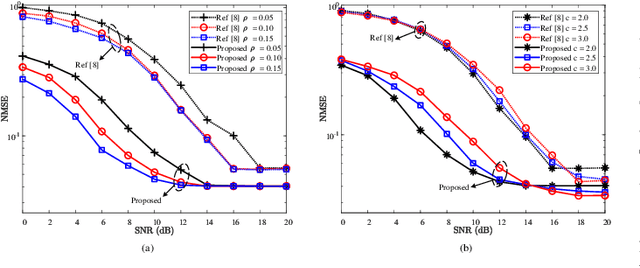
Abstract:Due to the discarding of downlink channel state information (CSI) amplitude and the employing of iteration reconstruction algorithms, 1-bit compressed sensing (CS)-based superimposed CSI feedback is challenged by low recovery accuracy and large processing delay. To overcome these drawbacks, this letter proposes a fusion learning scheme by exploiting the bi-directional channel reciprocity. Specifically, a simplified version of the conventional downlink CSI reconstruction is utilized to extract the initial feature of downlink CSI, and a single hidden layer-based amplitude-learning network (AMPL-NET) is designed to learn the auxiliary feature of the downlink CSI amplitude. Then, based on the extracted and learned amplitude features, a simple but effective amplitude-fusion network (AMPF-NET) is developed to perform the amplitude fusion of downlink CSI and thus improves the reconstruction accuracy for 1-bit CS-based superimposed CSI feedback while reducing the processing delay. Simulation results show the effectiveness of the proposed feedback scheme and the robustness against parameter variations.
Imaging dynamics beneath turbid media via parallelized single-photon detection
Jul 22, 2021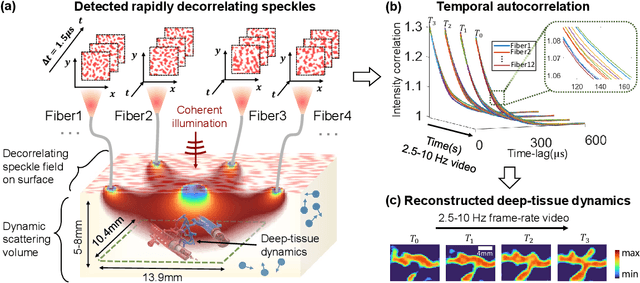
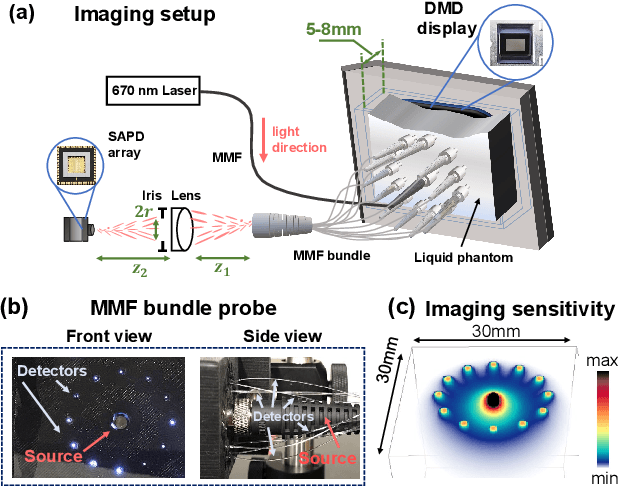
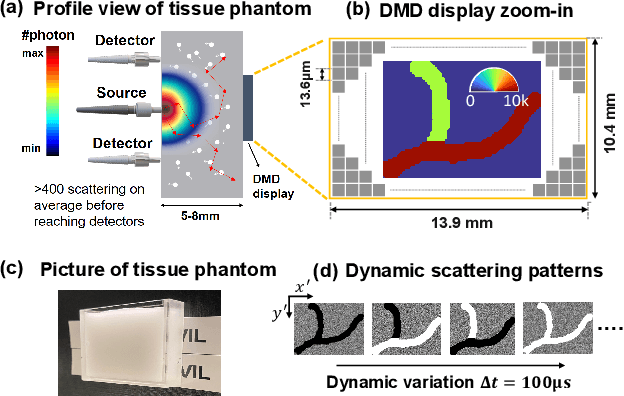
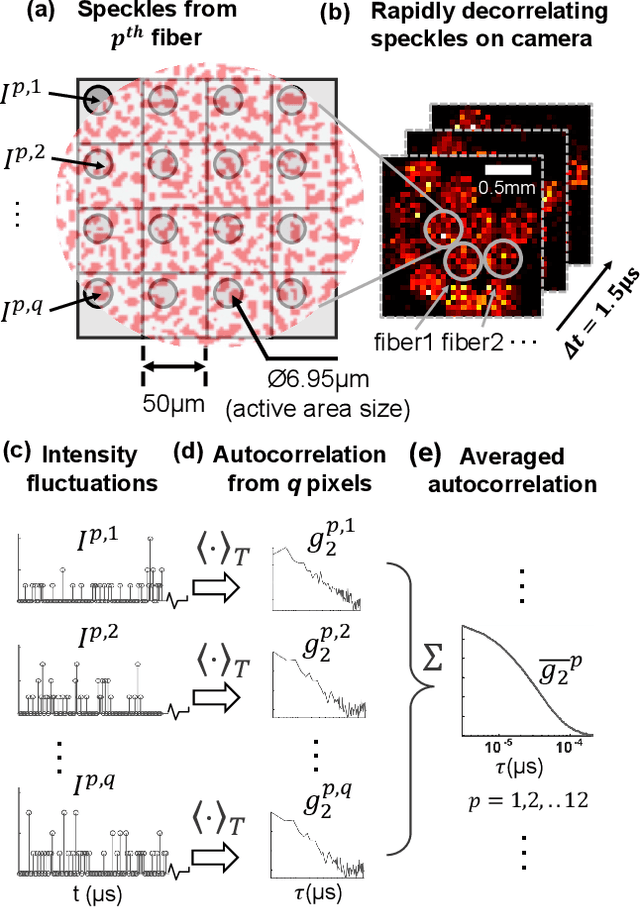
Abstract:Noninvasive optical imaging through dynamic scattering media has numerous important biomedical applications but still remains a challenging task. While standard methods aim to form images based upon optical absorption or fluorescent emission, it is also well-established that the temporal correlation of scattered coherent light diffuses through tissue much like optical intensity. Few works to date, however, have aimed to experimentally measure and process such data to demonstrate deep-tissue imaging of decorrelation dynamics. In this work, we take advantage of a single-photon avalanche diode (SPAD) array camera, with over one thousand detectors, to simultaneously detect speckle fluctuations at the single-photon level from 12 different phantom tissue surface locations delivered via a customized fiber bundle array. We then apply a deep neural network to convert the acquired single-photon measurements into video of scattering dynamics beneath rapidly decorrelating liquid tissue phantoms. We demonstrate the ability to record video of dynamic events occurring 5-8 mm beneath a decorrelating tissue phantom with mm-scale resolution and at a 2.5-10 Hz frame rate.
 Add to Chrome
Add to Chrome Add to Firefox
Add to Firefox Add to Edge
Add to Edge